The best moonshine still by hand. How and from what you can assemble a moonshine still at home
Sooner or later, everyone who has at least once tried homemade moonshine (or its variations - cognac, bourbon, liqueur, etc.) sets out to make the same thing, only even better. First, the owners are interrogated - as best they can, teach, show, lend. This is the first wave of moonshiners. Afterwards, he begins to explore the Internet in the hope of finding how to make a moonshine still with his own hands. This is the most inquisitive wave, which is trying to understand tons of information, what is true and what is false. We have already talked about how to manufacture and assemble individual parts of the unit, now it’s time to talk about how to assemble a full-fledged device.
History of the moonshine still
They first learned about moonshine back in the 4th century AD, when a Chinese alchemist compared the drink to clear wine distilled 9 times. Its technology in different times used by the Greeks, Romans and even the Egyptians.
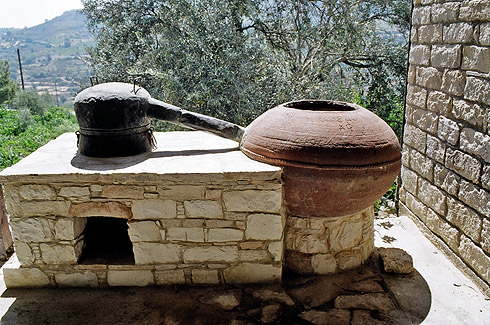
This is what, according to official documents, one of the first moonshine stills developed by the ancient Greeks looked like.
But if this unit was mostly made of stone, then the Arabs went further - and made the structure out of copper. This allowed the mash to heat up evenly, gradually, completely remove fusel oils (remember, extremely harmful to health) and create a drink suitable for internal use.
The term alcohol was also proposed by the Arabs; literally translated, the word meant an intoxicating drink - al gogol.
In the 9th century, a coil was invented in Persia - a copper tube was bent into several turns, but still left in the air for cooling.
Since the 10th century, with the help of alchemists and healers, moonshine literally began to flourish, combined with the development of recipes for potions and elixirs. At the same time, in Italy, the monk Valentius declares that he has invented the water of life, which is capable of turning old people into young men. Need I say that it was moonshine?
In the 15th century, Basil Valentin came up with the idea of immersing a coil in cold water to increase the alcohol condensate, and this was the starting point for the creation of a modern apparatus with a distillation cube, a refrigerator and a steamer.
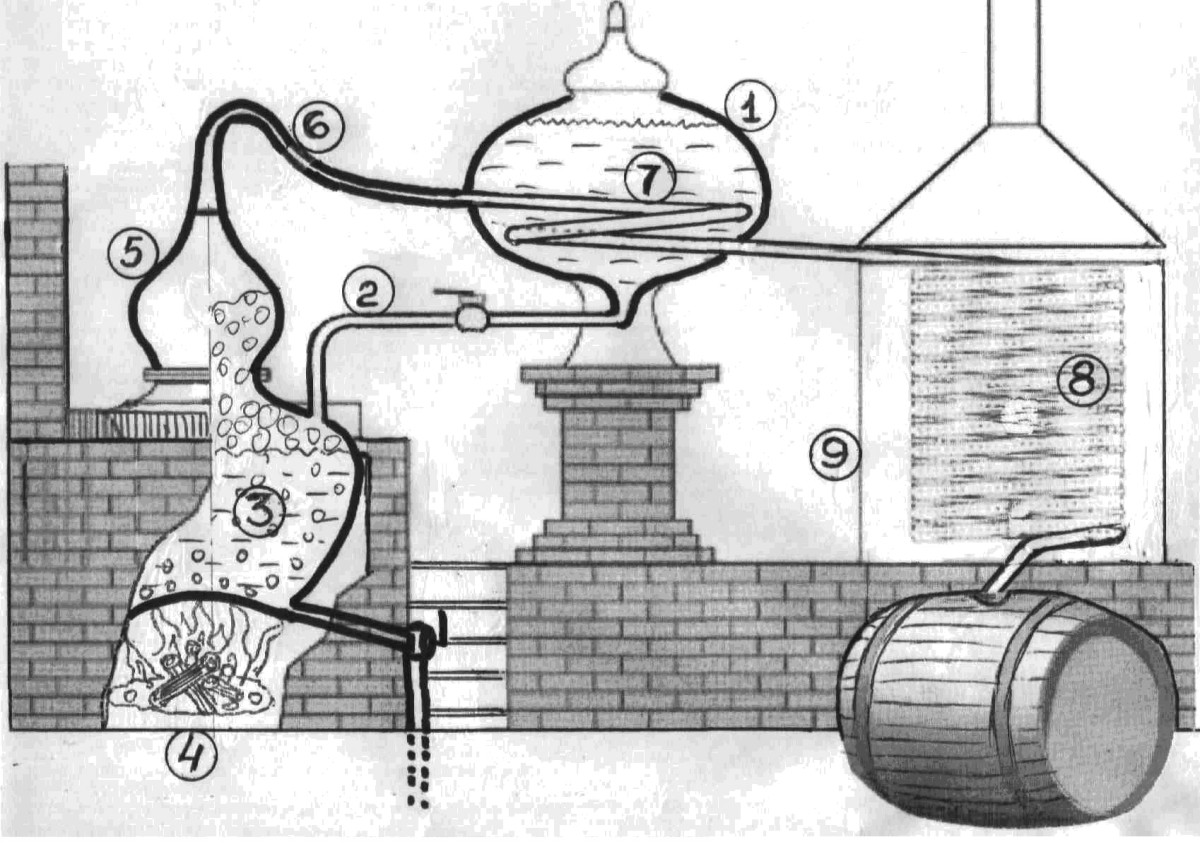
This is what the device looked like in the 16th century (the principle of operation has been preserved to this day):
- A vat for heating the tincture
- Tube for supplying hot tincture to the cube
- Stove
- Cap
- swan neck
- Coil
- Coil in the refrigerator
- Refrigerator with cold water
The first moonshine still in Rus'
In Rus', moonshine was first tried only in the 17th century, when a unit was brought from Venice to Tsar Alexei Mikhailovich as a gift.
Until the 17th century, the only homemade alcoholic drinks in Rus' were mead and mash. And only in the 19th century did they learn to create 96% highly purified alcohol.
On this short excursion history is over, now it's time for modernity.
Buy or collect
There is no clear answer to this question. Of course, for a beginner, it is much more preferable to buy a ready-made device, when there is no need to look for individual parts and bring them to perfection. But, on the one hand, such a purchase can cause a hole in the budget - a good device with normal performance will cost 15 thousand rubles or more, on the other hand, it is still more interesting to create and invent.
We will tell you how to make a moonshine still with your own hands, and from what materials.
First, let’s define what moonshine (distillate) is and how it differs from rectified distillate. The principle of obtaining one or the other is absolutely identical. A sugar-containing (less often starch-based) mash is prepared, yeast is added, then over a certain period of time the mushrooms create a colony and secrete waste products. Actually, they are precisely the concentrate of various alcohols, of which only ethyl is suitable for internal consumption.
Under the influence of temperature, the mash decomposes into a liquid residue and alcohol-containing vapors, which during the distillation process break down into gaseous and liquid fractions.
Even after repeated distillation, it is not possible to clear the drink of all harmful impurities. The only way to get perfect pure product, is rectification using a drawer or distillation column. In this case, alcohol-containing vapors are divided into fractions in several stages. Do distillation column It’s not easy to do it yourself, and a completely reasonable question arises - is it necessary to obtain pure alcohol in this way, if it can be bought at any pharmacy?
Rectified alcohol is extremely harmful to health precisely because of its purity, since pure poison is absorbed by the body much faster and better than moonshine with a certain amount of harmful impurities. In addition, all famous drinks - bourbon, rum, whiskey, Calvados, scotch, etc. - are made on the basis of distillate.
So, taking into account the given characteristics of moonshine, it is clear that the main stage of production is heating the alcohol-containing liquid to a state where the alcohol begins to separate. Afterwards it is cooled until it is converted into a liquid fraction in the form of a finished drink.
Taking this into account, we can determine the main components of a moonshine still:
- a distillation cube, where the mash is heated to the required temperature;
- refrigerator - a storage or flow-through container with cold water where the coil is cooled;
- coil - a spiral tube made of copper, stainless steel or glass, through which alcohol-containing steam moves and is divided into fractions;
- steam trap - catcher of fusel oils and mash residues;
- receiving tank - a place where cooled moonshine flows;
- connecting elements.
This is the first and main element of the moonshine still, on which the efficiency and final taste depend.
Most often, milk cans, pressure cookers (multi-cookers), and beer kegs are used as such. Less commonly, a distillation cube is made by hand from stainless steel or steel, welded into a container, but this option is not reliable. On the one hand, the mash will stick to the stainless steel, and you won’t be able to stir it due to its tightness. On the other hand, the slightest error in the weld can lead to the cube simply bursting when the mash boils, when the pressure reaches 180-220 Pa.
How to make a still from a can

This is the easiest option alembic, since the can is relatively airtight, especially if we are talking about a new container. But its “adaptation” for distillation has its own characteristics.
The rubber gasket on the lid of the can is absolutely not suitable for heating - the mash will absorb a specific aroma, which will immediately affect the taste of the finished drink. It is optimal to use silicone gaskets, or even better - aquarium silicone. Experts advise using food-grade silicone as such gaskets, which is used to make baking molds. But in general, this option is suitable for sealing the lid and will not give any taste or smell.
How to make a silicone seal correctly
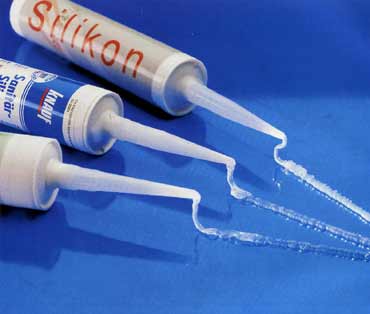
This process is carried out in several stages, the minimum of which should be three. First, apply aquarium silicone sealant to the edges of the lid, let it dry completely, apply a second and third, also leaving time for drying. After the third layer has been applied, apply regular cellophane to the neck of the can and close the lid. Leave for several hours to allow the silicone to dry completely. The result is a truly airtight vessel that can be used for several years.
To prevent the can from becoming like a colander over time, wash it thoroughly after each use. You can use regular or laundry soap and plenty of running water. The use of soda is strictly prohibited. Stainless steel or aluminum reacts very poorly to alkali.
If you don’t want to change the rubber gasket to silicone, you can simply wrap it with several layers of overlapping fum tape. This is also a fairly tight connection.
Some “experienced” moonshiners recommend using dough to seal the joint. It would seem, why not? It seems like a decent sealant, and it smells like bread in the room, and not fusel during the cooking process. But! After the first volumetric distillation, when you have to start the unit several times, you will get tired of constantly scraping off the dough and gluing a new one. Scraps of dough all over the kitchen, broken nails and wasted time are unlikely to make the process enjoyable.
To connect the can with the coil, make a hole on the lid for a 22 mm pipe and a 12 mm coil using a 0.5 inch thread. You can buy an adapter at a plumbing supply store.
What else to look for when choosing a flask for a moonshine still:
- the material of manufacture is stainless steel, since aluminum will withstand a small number of cycles;
- the minimum volume is 25 liters to obtain 4-4.5 liters of moonshine;
- wide neck, which is convenient to work with - pour mash and wash after cooking;
- wall thickness and overall build quality directly depend on the price, and ensure a period of normal operation.
Distiller (moonshine still) based on a milk can
How to make a distillation cube from a pressure cooker (multi-cooker)
Scheme of a moonshine still based on a pressure cooker:

This is a minimum program for a beginner. Today, every second person tries to make a moonshine still with their own hands using a pressure cooker. And there is a completely logical explanation for this:
- price - the cost of the most inexpensive pressure cooker is 1500-1700 rubles, which is quite acceptable for any budget;
- tightness - this is an absolutely sealed device that does not require any additional manipulations;
- ease of inserting fittings into the lid - anyone can handle this.
The downside, it should be noted, is much more significant than all the advantages - this is the volume. The bowl of the largest household pressure cooker is only 6 liters, respectively, the mash will fit only 4.5 liters, since the volume should not exceed 2/3 of the total quantity. With this amount of mash after double distillation you will get a little less than 750 ml of moonshine. You can try, but it’s unlikely that you’ll be able to taste it.
Screw a fitting into the place of the valve on the lid, to which attach a connecting hose (silicone or copper).

If you don’t want to reinvent the wheel and look for suitable option To make a cube, purchase a ready-made one. Average price such an element depends on the volume - 12-liter up to 4,000 rubles, 25-liter - from 5,500 rubles, etc.
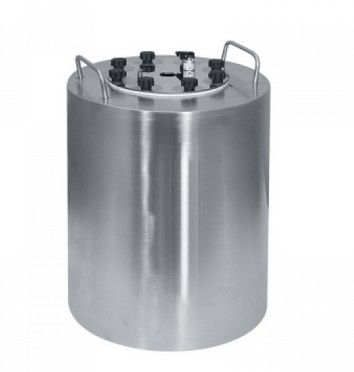
Moonshine still from a pressure cooker with a steamer on video:
Fridge
An equally important element of a homemade moonshine still, on which the distillation speed and volume of the finished drink depend.
If the water in the refrigerator is not cold enough, the volume of moonshine is reduced by 15-20%.
Refrigerators for moonshine stills are divided into 2 types:
- flow-through;
- cumulative.
In flowing water, as the name suggests, it constantly moves through the coil without having time to heat up. In order to make such a unit, it is enough to connect two hoses to the container - the inlet, as a rule, from the tap, and the outlet - from where the water comes out into the sink.
The storage tank is a closed container into which water is first poured and drained as it heats up. This is the worst type of refrigerator because it does not allow the coil to cool completely and constantly, which reduces condensation and reduces the amount of final product.
A storage refrigerator is installed only if it is not possible to make a flow-through one. It’s precisely the lack of opportunity, not laziness or lack of time.

This type of equipment is quite compact in size, where the main area is occupied by the coil. The refrigerator itself is closed on both sides, but two tubes are connected to it - receiving and discharging water. Making a refrigerator with your own hands is not difficult, but it is necessary to ensure that it is level in relation to the device so that the water moves constantly.

A flow-through refrigerator is more productive, unlike a storage refrigerator, even with a smaller coil size. At the junction of the two media, the tube is instantly cooled, which ensures faster separation of fractions.
Manufacturing process
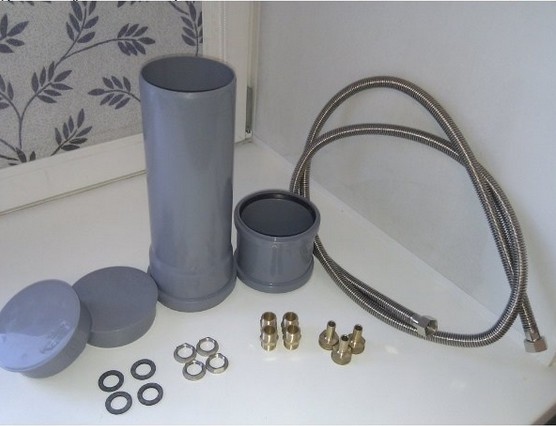
You will need:
- pipe and adapter weaving - 300 mm;
- 2 meters of bellows hose for the coil;
- half-inch nipples;
- 3 half-inch nuts;
- soldering iron;
- gun and silicone;
Procedure:
- Roll up the bellows hose into a spiral

- Make holes in the pipe and cut the plastic with a knife
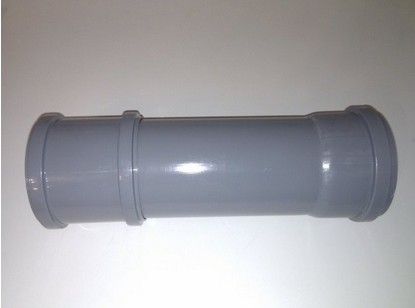

- Screw in the nipple
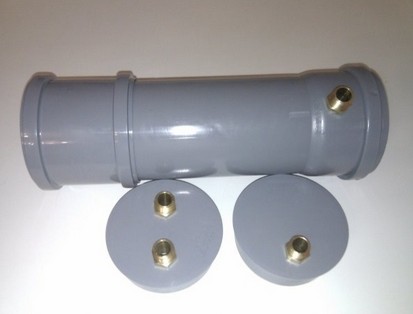
- Install gaskets and tighten nuts
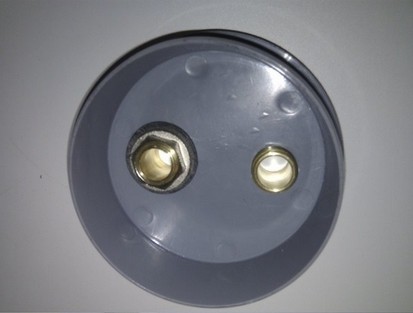
- Screw the coil to the plug
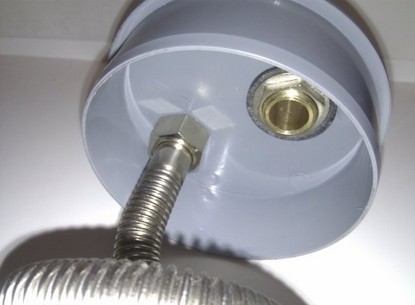

- This is what the entrance and exit look like
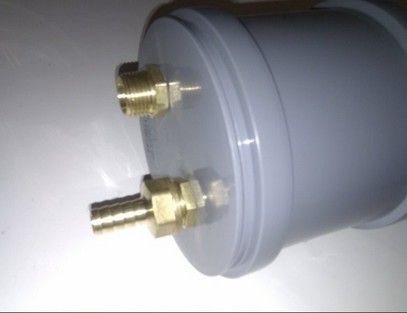
- Anything that leaks or leaks is filled with sealant; the vessel must be completely sealed.

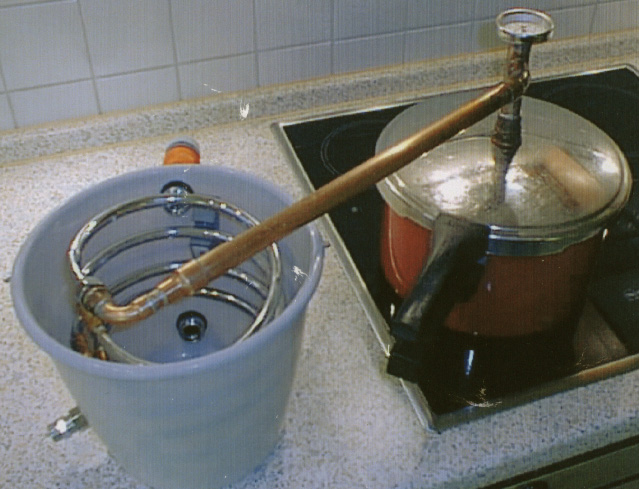
As such a device, a bucket or tank with a volume of about 20-30 liters is usually used, where a hole is made in the lower segment for collecting water.
In non-flowing devices, water is always drained from the top, and always poured into the refrigerator from the bottom.
The simplest and most affordable is a regular plastic bucket. In winter, it is easier with such a handy device, since you can add snow or ice, which is much better for cooling the coil than water.
When choosing a storage refrigerator, try to keep the temperature in the distillation cube at minimum heat in order to reduce the amount of alcohol-containing steam released and, as a result, increase the volume of the finished moonshine.
In order to check how effectively the coil is cooled, periodically test the escaping moonshine on your wrist. Ideally, it should be cool, worse - if warm, and even worse when the drink is hot - in this case, a third of the steam comes out unprocessed. In addition, this is also dangerous, since the distillation cube is heated over an open fire, the alcohol can catalyze and there will be a big disaster.
Coil
The best material for the coil is copper. This is a relatively inert material that does not react with alcohol materials, has good thermal conductivity and an adequate price.
Those who are truly professional in preparing moonshine only have a copper moonshine still based on such a coil. Any experiments. Including fragile glass, they are fraught with loss of quality of the drink and the raw materials.
How to make a coil
Before we begin the description, we note that a coil is a tube connected to a distillation cube (if there is a steamer, with it) and placed in cold water, through which alcohol-containing vapors move and the fractions are separated into gas and moonshine.
The longer the coil and the more compact its spirals, the more the steam is cooled and the greater the amount of condensate.
You will need:
- copper tube with a diameter of 15-20 mm and a length of 2000 mm;
- base for winding the tube, fixed in a vice.
Before you start screwing the tube onto the base, it must be filled with sand. This is done in order to prevent deflection or one-sided deformation, which will subsequently retain condensation. Close the tube on one side with a wooden or cardboard cap, pour sand in a thin stream, periodically tapping it on the table so that the sand is compacted well. When the tube is filled to capacity, close the other end with a similar clip and begin to wind it onto the base, making even turns and trying to ensure that they do not touch each other.

This is what a ready-made coil looks like, which is immersed in the refrigerator and connected with hoses through fittings to a cube or steam chamber.

That's it for the assembly mandatory elements The moonshine still is complete, all that remains is to find out what hoses can be used and what materials are acceptable when working with alcohol.
Well, for now let’s focus on such an optional, but extremely useful device as
Sukhoparnik
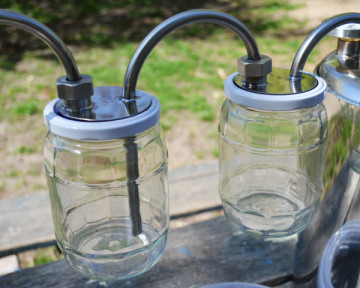
We do not know whether there were discussions about the need for a steamer in those ancient times, which were written about at the beginning of the article. But now there is fierce debate on this issue. Some insist that fusel oils should be removed as much as possible, others claim they are useless and a waste of time.
Without actively taking either position, we will present only dry facts.
The steamer is really not an integral part of the moonshine still, and it is installed at will. Structurally, this container is 10 times smaller in volume than the distillation cube, which is located between it and the coil.
The main task of a steam chamber is to instantly reduce pressure and, as a result, temperature due to different media. When the steam enters this container, it suddenly becomes liquid, but is immediately pushed out by the next portion of hot alcohol-containing steam from the cube. And although this is only a moment, during this time some of the fusel oils have time to settle on the walls of the steam tank. With double or even triple distillation, practically no fusel remains in the finished drink, which has a very beneficial effect on well-being.
How does a steam generator work according to the laws of physics?
While the water is boiling in the distillation cube, the alcohol begins to separate and evaporate. Taking into account the fact that boiling is a rather violent process, the alcohol fractions have time to “pick up” the heavier fractions of fusel oils. Probably everyone has heard that moonshine is often called fusel - precisely because of the characteristic smell that fusel oils emit. The less fusel in moonshine, the less aggressive its aroma and the more acceptable its taste. It is not possible to completely get rid of oils; this can only be achieved using a distillation column, but no one set out to obtain medical alcohol.
The vast majority of alcoholic drinks are bourbon, whiskey, rum, Calvados, etc. made on the basis of moonshine with a certain amount of fusel oils. The production process varies in nuances, but in general it is the most banal distillation of mash.
Collecting fusel oils with a steamer allows you to make the drink, on the one hand, not so strong and “fragrant”, on the other hand, safer for health with an almost imperceptible feeling of a hangover (if consumed wisely).
Particularly common is the use of three steam tanks at once, located relative to each other in a cascade. With this organization, the strength of the drink reaches 80% already on the first distillation. This will really be a very high-quality and highly purified product that can be consumed immediately after distillation, and not wait until it is purified with a carbon filter or potassium permanganate.
Three cans in a cascade is the optimal number. Less is not enough, more is a waste of time, since after the third can, each subsequent can does not perform any function.
How to make a steamer from a can
We remind you that the volume of the container should be 10 times less than the volume of the distillation cube. If you have a 20-liter cube, take a 2-liter jar, for a 30-liter jar, take a 3-liter jar.
The method of preparing such an element is quite simple and suitable for any volume. All manipulations are carried out with the lid - holes are made and fittings are cut into. Next, the lid can be put on any jar with a threaded neck.
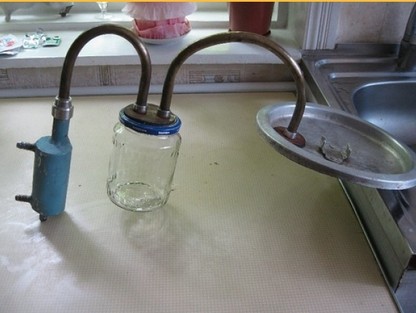
You will need:
- screw-on jar lid;
- 2 fittings;
- connecting tubes.
Cut 2 holes in the lid - they can be made with a screwdriver in a circle or with a knife, so that there are no burrs.
Insert the fittings and connect them to the hoses.
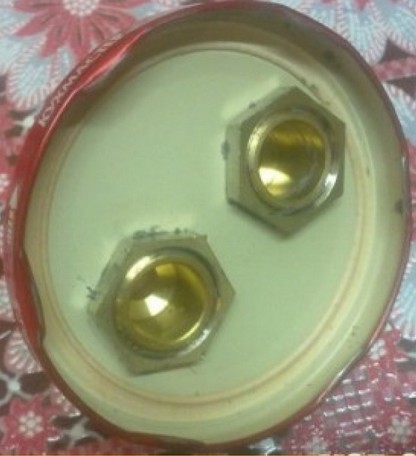
The steamer is placed immediately after the distillation cube. In any other place it is of no use. It is necessary to periodically drain the accumulated liquid so that excess does not enter the coil and spoil the taste and aroma of the product.
By the way, a steamer can be used not only as a fusel oil trap, but also as a moonshine flavoring agent. Here the same process of sharp cooling of the steam and its movement further occurs, but with the collected amber of berries or herbs.
As an aromatic component in a jar you can use:
- dried fruits - apples, pears, apricots;
- berries - any, preferably dried, they give off more flavor;
- spices - any to taste, you can use hops, suneli, cinnamon, vanilla, etc.;
- aromatic herbs;
- citrus fruits - orange peel, lemon zest.
Since such a binding of aroma will be subtle and not at all palatable, you can try a variety of additives. In this case, experiments will only be beneficial, even if the result is not impressive.
Connecting tubes
The finished moonshine still is a detachable connection of all required elements using threaded connections. There is no need to look for additional tubes and choose their quality in order to connect everything together.

There are completely permanent connections, for example, the lids of the distillation cube, steamer and refrigerator. This is done to facilitate labor and installation.
You can, of course, make the work easier when assembling a homemade moonshine still by connecting all three pipes by welding, but this will not in any way affect the taste of the final product, but maintenance can make it very difficult.
The most optimal way to connect the elements is a silicone hose. Some people don’t understand the difference between PVC and silicone and don’t even pay much attention when choosing. We explain - polyvinyl chloride is a non-inert material with respect to alcohol. When in contact with hot alcohol-containing steam and alcohol, PVC releases toxic substances, which in high concentrations are harmful to humans. It is clear that nothing will happen to you in 1-2 times, but if we are talking about systemic use, it is better to refuse such a connection.
How to distinguish silicone from polyvinyl chloride (PVC)
Set fire to a piece of both materials. PVC burns hard, smoky, with a very specific smell. Silicone burns with a subtle aroma, does not smoke, and light ash remains after combustion.
Silicone feels much more pleasant to the touch than PVC, it feels silky.
If you suddenly find yourself in a dilemma - silicone or PVC - outside in the cold, know that silicone, even at -10, remains flexible and elastic, and polyvinyl chloride hardens, although it does not lose its properties.
What metal is suitable for use
Despite the abundance of opinions on this matter, there can only be one clear answer - food-grade stainless steel. It is this material that does not react with any of the elements in the moonshine chain and is easy to maintain and use. And over the entire period of time it does not form deposits that are of little benefit to health.
Previously, it was believed that copper was the “head of everything,” since copper moonshine was ubiquitous. However, this is a misconception. Copper began to be actively used during Soviet times. Because it was an affordable material both in price and in quantity. If we talk about a really correct tincture, then it’s better oak barrel nothing to be found. Oxygen penetrates through its walls, aldehydes and ethers evaporate, which, by the way, are formed, among other things, when the copper elements of the device come into contact with hot alcohol vapor.
Aluminum reacts negatively to vinegar, which is always present in mash. In this case, poisonous salts - alum - are released.
Glass, which is inert (not active) to aggressive environments, is also considered optimal, but a moonshiner’s kitchen bears little resemblance to a laboratory, and this material is also very fragile.
Of course, you can get poisoned or die more quickly from general intoxication due to alcohol abuse or purchasing low-quality products than from copper oxide. Moreover, as a coil, copper has no analogues at all in terms of thermal conductivity and manufacturability. Therefore it is quite justified combination combination materials. This can be a cube made of stainless food steel or an aluminum can, and a refrigerator with a copper coil in a stainless or plastic case.
And finally, a video on how to make a moonshine still with your own hands
Moonshine stills are easy to make. The circuit of a moonshine still consists of two parts - a heated tank with mash and a coil. You can add a steamer to a homemade moonshine still and it will greatly improve the taste of the distilled moonshine. Or you don’t have to use a coil; in the article above we already gave an example of a method of making moonshine in which you can actually get by with just a saucepan.
Many today prefer to buy a moonshine still on a website on the Internet or from a special company. But the cost of a purchased unit is usually high and amounts to 8-16 thousand rubles. At the same time, you can make a moonshine still with your own hands at much lower costs and cost 1-2 thousand rubles. In this article we will talk about making a simple moonshine still from a saucepan using improvised means.
To assemble a moonshine still, you will need the following tools: a hacksaw, a drill and pliers. Of course, you can use a Dremel instead of a hacksaw and drill, but this is at your discretion.
This design does not require drawings of a moonshine still, everything can be done virtually “by eye”, and the article has a sufficient number of photographs so as not to make mistakes during production.
The list of materials for manufacturing looks large, but all the components are easy to get and they are very cheap.

We will need: a large saucepan with a lid - this will be a heated tank, a piece of plastic plumbing pipe (45 mm in diameter) and 2 meters of aluminum or copper tube (the latter can be taken from an old refrigerator) - this is for making a coil.
2 fittings with hoses, a half-inch plumbing coupling and a nut for it, a dropper from a pharmacy or another flexible and thin tube, a piece of rolled aluminum (an old curtain or corner will do, you can take runners from an old children's sled), fluoroplastic tape (at a plumbing store - fum lena for pipes), a couple of anchors with nuts and tin from a beer can.
To make a steamer, you need a jar with a tightly screwed lid (suitable for store-bought gherkins or salted mushrooms).
The following adhesives will be required: a package of epoxy glue and cyanoacrylate superglue (a couple of tubes).
As you can see, a lot can be found already in the house or in the rubble of old things in the garage, and even if there is a lack of materials, you can buy all this at the flea market very inexpensively.
How to make a coil
Making a homemade moonshine still begins with winding a coil.
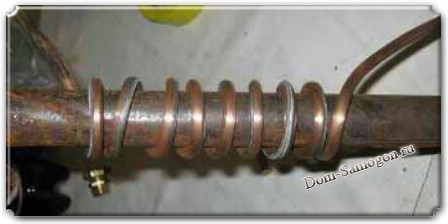
The moonshine still’s coil is the main thing in the entire unit! Look at this article, a lot of interesting things are described there about the coil and its installation.
To prevent the tube from being crushed during the manufacturing process, fill it with dry sand, tamp it, clamp the ends of the tube with pliers and carefully wrap it around any round object of a suitable size. The finished coil should be inserted into the plumbing pipe with a gap of approximately 0.5-1 cm.
Attention! All actions with the tube (bends for installation, etc.) must be performed only with a tube clogged with sand! Otherwise, the tube may flatten or break!

This is what the coil looks like before it is inserted into the cooling pipe.

We cut off the cooler tube 4-5 cm from the end of the coil.

We will modify the fittings for water supply and drainage.
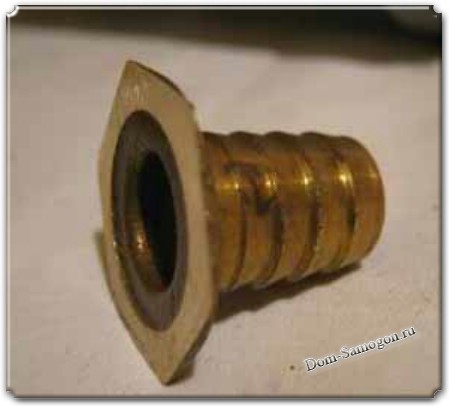
They are glued overlapping onto the cooler, so we cut off the sides using a saw or Dremel. This is what the device looks like.
We heat the finished fittings on a gas stove or lighter and press them tightly to the plastic pipe. This will allow you to form flat areas to which the fittings will be glued.

After this, glue the fittings to the pipe using cyanoacrylic superglue. If such a connection seems unreliable to you, you can clean the area around the glued fitting, degrease it with acetone and additionally coat the outside epoxy glue or use a heat gun. But, as practice shows, if there are no blows or attempts to deliberately break off the fitting, then it will hold perfectly even with superglue.
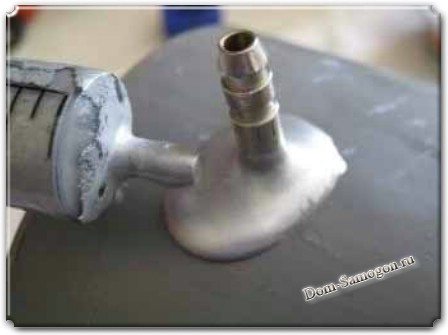

After this, carefully drill holes in the pipe using the fittings as guides for the drills.

Inside you get something like this hole. Burrs can be cut off with a knife or the inner surface can be sanded with sandpaper.
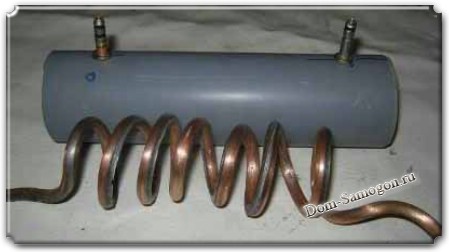
There are 2 fittings - for supplying and discharging running water through the coil of the moonshine still.

The end caps are cut from tin beer cans. You can use plastic caps for three-liter bottles - they are thicker and easier to adjust to the diameter of the cooling tube.

We make cutouts in the covers for the coil tubes and carefully glue them into the cooler with superglue. The main thing here is to fix and fill the gaps between the cover and the cooler. To seal cracks, you can use a hot glue gun or soda. Soda is poured along the contour, a “side” is carefully formed using superglue, and a very rigid composite is obtained.
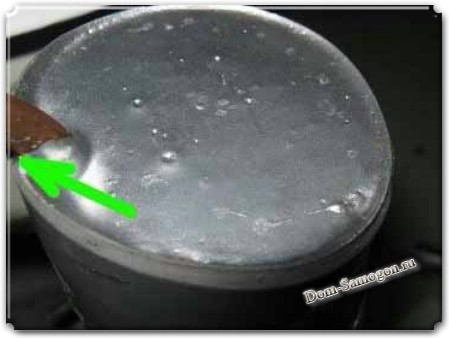
Now it is necessary to completely seal the coil. To do this, dilute epoxy glue (you can mix it with silver or myrosphere to give a noble shade and reduce glue consumption) and fill the end of the cooler tube. All that remains is to wait for the glue to polymerize and repeat the procedure for the other side of the cooler.
Making a hotbed
It is better to make home moonshine with a steamer. A steam reflux condenser is necessary to remove fusel oils between the distillation tank and the coil. Heavier fusel oils released together with alcohol in the form of vapors settle in the steamer and the moonshine turns out more tasty. Headache during a hangover - this is the result of drinking fusel oils along with moonshine. Moonshine that was made on a machine with a steamer does not give you a headache!
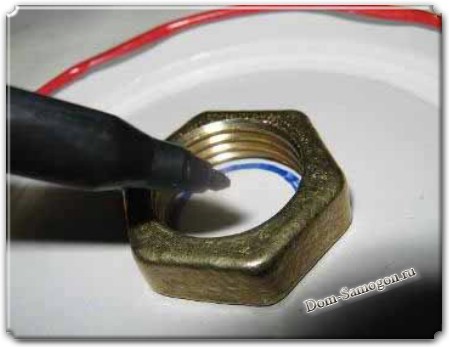
A hole is cut in the lid of the jar for the coupling.
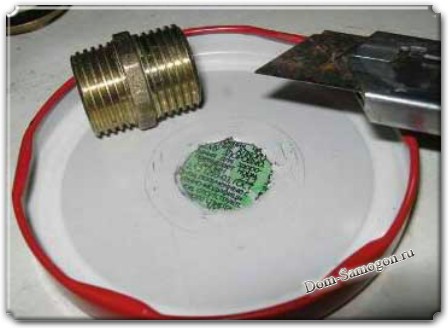
We clamp the inserted coupling with a nut. This must be done carefully, so that you do not then have to use a rubber gasket for the coupling to ensure sealing. Drinking moonshine with a rubbery taste is not very pleasant, so be careful and be careful again!

We try on and bend the tube from the coil to the steamer, and take the rest of the tube to the pan.
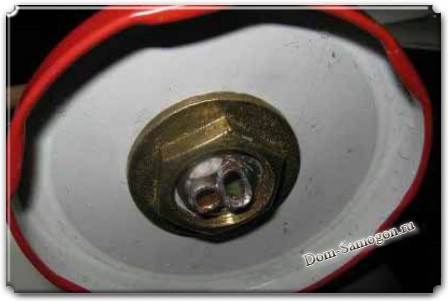
Now we clean the surface of the tubes with sandpaper, wind them together with threads and insert them into the steamer. We seal the space between the tubes and the coupling from the inside using cotton wool and fill the outside with epoxy.
After the epoxy has “set”, remove the cotton wool and check the tightness. The steam steamer should not “suck” air!
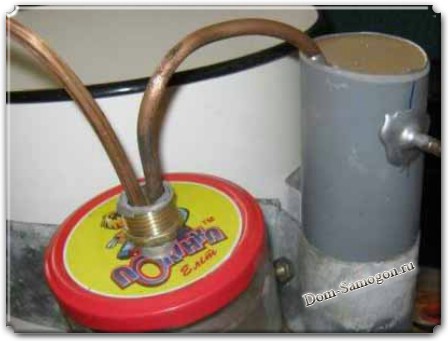
If everything is fine, we proceed to the manufacture of the distillation tank.
Distillation tank of a homemade moonshine still
We make a heated container - a distillation tank - from a large saucepan.
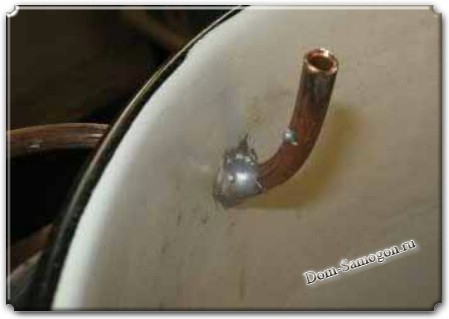
To do this, drill a hole along the diameter of the tube in the sidewall, 4 cm from the top. We put the tube inside and bend it so that there is 4-5 mm between the lid and the edge of the copper tube. In this case, the tube will only collect sublimation vapor and will not “choke” if the mash boils.

We seal the tube with the pan using the usual sealing procedure with epoxy glue.
Now you need to ensure the lid of the moonshine still is sealed.
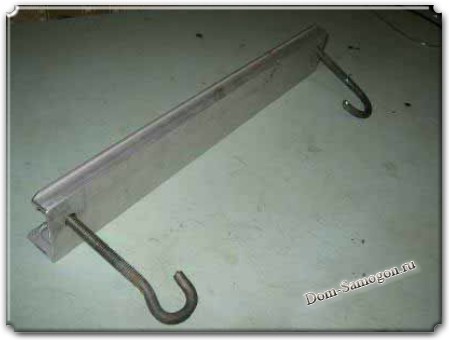
To do this, we make a holder from anchors and an aluminum profile.
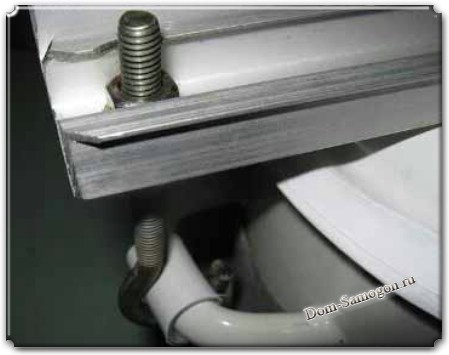
The ear of the anchor heats up and extends. An isolette is wound around the handles of the pan or a piece of PVC tube is put on (cut up). This will allow you to more “softly” regulate the force of pressing the lid onto the pan.

In the places where the lid is pressed, pieces of bottle cap are glued to the holder; they will also cushion and protect the lid of the pan from scratches.
Homemade moonshine still
This is what a homemade moonshine still looks like assembled.
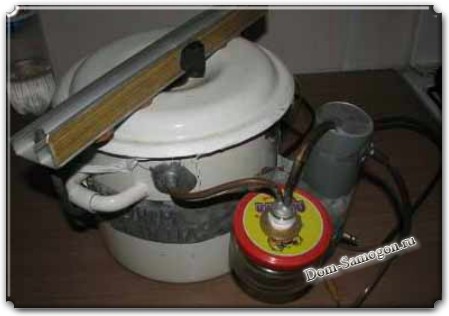
In this case, a furniture aluminum profile is used as a holder. The trim was taken from a kitchen manufacturing site. If you don’t have the opportunity to get aluminum, you can use a piece of stick from a hockey stick or a handle from a shovel. The latter, of course, is too massive, but cheap and can be easily bought at the “Everything for the Dacha” store.
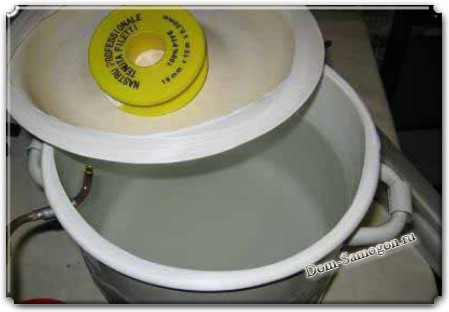
All that remains is to ensure that the lid fits tightly to the pan. Here fluoroplastic fum tape from the hardware store comes to our aid.
When preparing moonshine at home, wrap 6-7 layers of this tape around the edge of the pan and, covering it with a lid, attach the structure using anchors.
All that remains is to perform a test run of the homemade moonshine still - to do this, fill the pan halfway with water, seal it and place it on the stove. Hot steam will go all the way and clean the system. The same thing needs to be done every time after you have made the next batch of moonshine and are going to put the device away for storage.
![]()
When producing moonshine, a hose from a dropper is attached to the outlet of the coil and connected to the receiving container. Hoses are put on the cooler sockets, cold water is supplied to the lower one, and water is discharged from the upper one to the sink. It is better to place the coil at an angle to the surface and place it at a distance of 20-30 cm (or more) from the pan. The photo shows the unit intended for transportation. At the place of use, the tubes will be carefully bent and the steamer will take its place on the straight line between the pan and the coil.
As it turns out, the moonshine department is very popular among subscribers. And if earlier the topics concerned mainly individual parts, today we will tell you how to make a simple moonshine still with your own hands.
To begin with, it is worth deciding that moonshine brewing is the production of alcohol by distilling mash at home. Alcohol is always produced using the same technology, regardless of the scale - for home production or industrial production. Starch or sugar-containing raw materials are produced, to which water and yeast are added. During the fermentation process, the so-called an artificial world where single-celled fungi live. The result of their vital activity is ethyl, methyl, propyl and other alcohols with the addition of aldehydes and acetone.
Since all products, except ethyl alcohol, are harmful to humans, the task of moonshine brewing is to obtain pure ethyl alcohol in a non-lethal concentration. For these purposes, rectification is carried out, that is, the product is divided into several fractions. You can buy or, but it’s much easier and faster to make the simplest moonshine still.
The simplest moonshine still
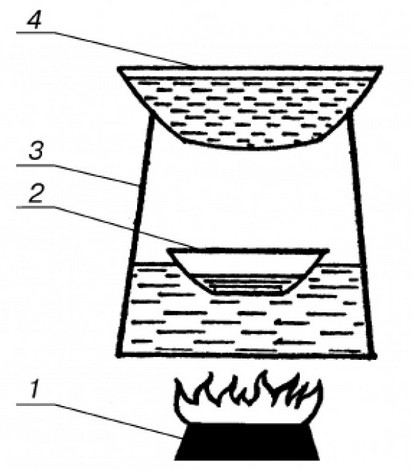
In order to make such a design, you will need only 2 plates of larger and smaller diameter (in Fig. 2 and 4) and a saucepan (in Fig. 3).
This design works as follows. Braga is poured into the pan. A plate of smaller diameter is placed on top of the spacers so that it does not plunge into the boiling mash. Place a plate of larger diameter on the pan, into which cold water is poured.
During the boiling process, alcohol vapors are released and settle on a small plate. As a result, you get a minimum amount of moonshine (from 1 liter of mash no more than 80 ml) with a high concentration of fusel oils. Honestly speaking, such moonshine is not only dangerous to take internally, but even used externally. This method was very popular in the Soviet Union during the Prohibition era. It is clear that the number of poisonings with such a surrogate was close to the absolute majority, which is where the belief that moonshine is pure poison came from.
In this case, it is not moonshine that is dangerous to health, but the concentration of hazardous substances - fusel oils, acetone and aldehydes. Only double and even triple distillation can produce a product that is pure and safe for life and health.
We have provided this information only to describe previously existing methods. We do not recommend making such a device at home - you will not be able to drink, and the smell in the apartment will linger for at least a week.
How to make a simple moonshine still
In this case, the design includes a distillation cube and a refrigerator. This is also a simple option, but it allows you to get a high-quality drink.
Always distill the distillate at least 2 times and use a steamer. This way you will get rid of harmful fusel oils as much as possible. Afterwards cleaning with charcoal is necessary.
Alembic

Any enameled or stainless steel container with a tight lid is suitable for this. The latter should close so tightly that it is not knocked out by excess pressure from the inside.
The second prerequisite is the presence of an outlet pipe through which steam that has not yet been divided into fractions will move. For this purpose, a through hole is made in the lid and a fitting is screwed in.
The third condition - tightness - smoothly follows from the first. If you ensure that the lid is securely fastened to the cube, the seal will be ensured. Some people cover the lid with dough, others use silicone gaskets. We recommend using pressure cookers. The price of the simplest model is 1500-2000 rubles. If you plan to brew moonshine more than once, it makes sense to buy it.
However, the pressure cooker has one serious drawback - its volume. The maximum we have seen on sale is designed for 6 liters, so you will fill 4.5 liters of mash (no more than 2/3 of the volume). This yields a little less than a liter of moonshine. It won't be enough, but it's enough for home use.
If this volume does not suit you, buy a special distillation cube with a capacity of 10 liters or more. The average price is 3200-4000 rubles.
A milk can with a lid that screws on tightly will be an affordable and suitable distillation cube. It will really need to be coated with dough after pouring the mash, but this is even a plus - the house will smell not of fusel, but of fresh baked goods.
How to make a still in just half an hour - video
Fridge
The refrigerator in the moonshine still is divided into 2 main types depending on the method of water supply:
- filler (storage);
- flow-through
The first option is very, very bad in terms of making moonshine. This type of refrigerator can only be used if there is water in the house. big problems. The operating principle of such a refrigerator is based on immediately pouring cold water and replacing it during the brewing process.
What's wrong with this refrigerator? The fact is that the water still heats up, even if you change it often enough. The warmer the water, the slower the separation into fractions occurs, the less, accordingly, you will get the finished product.
A flow-through refrigerator is connected to a water supply and the entire time cooking is in progress, water passes through it, physically not having time to heat it to a critical limit.
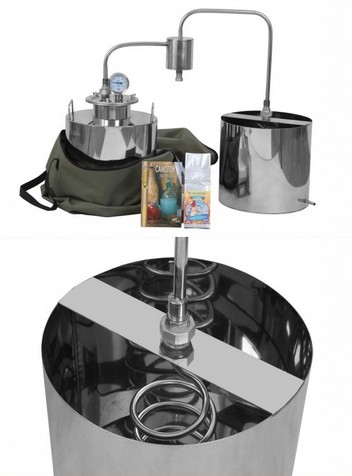
A flooded refrigerator can only be used if there is no real possibility of connecting the water supply.
Coil
An essential element of any refrigerator is a coil - a glass, copper or stainless steel spiral tube through which alcohol-containing vapors move from the distillation chamber to the receiving container, simultaneously being divided into vapor and liquid fractions.
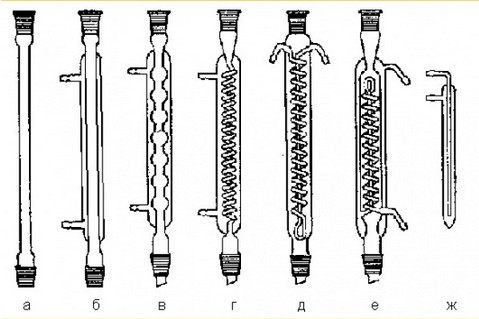
Some moonshiners prefer to use laboratory coils made of glass. Let’s say right away that our kitchen is far from a laboratory and people walk here unprepared for such almost sterile conditions. And glass things tend to break. It is best to use a copper coil, which has a high degree of heat transfer, is safe to use and costs literally pennies.
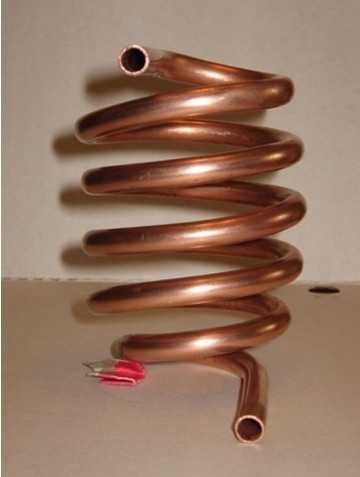
A refrigerator with a copper coil includes the following required elements:
- container for water;
- coil with 2 fittings - vapor inlet and moonshine outlet;
- 2 fittings for inlet/outlet of running water for cooling.
The photo shows examples of the simplest and therefore most effective refrigerators.
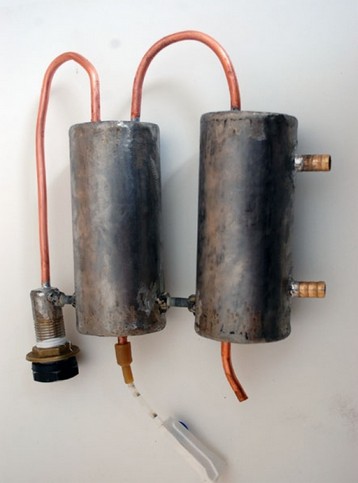
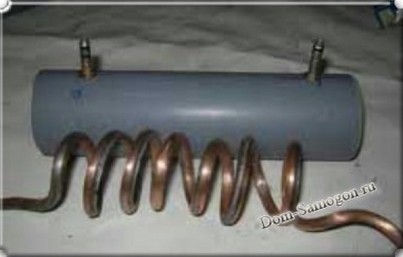
In the video you can see how to make the simplest refrigerator based on a corrugated gas flexible pipe. Just 1 hour and you can start working.
Final assembly
Actually, at this point the production of the moonshine still is almost completed. All that remains is to put all the components together.
For connection you must use only (!!!) silicone hoses. It is prohibited to use PVC hoses when distilling alcohol; this is very, very dangerous.

In order to distinguish a silicone hose from PVC, it can be set on fire. There will be no smell when burning. At the same time, the hose itself is pleasant to the touch.
Sukhoparnik
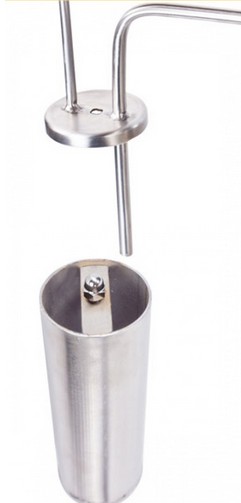
No matter what anyone says about the necessity or uselessness of this detail, we insist that the product must be as clean as possible. Not like rectified alcohol, it really is practically poison, but in such a way that in the morning you can clearly remember the events of the previous evening.
A steam steamer is used to separate fusel oils from alcohol-containing steam and prevent the ingress of mash residues into the finished product.
You can purchase a ready-made steamer, which will cost 1800-2200 rubles, or make it from an ordinary can.

Take a 1- or 2-liter jar with a screw-on lid. Make holes in the lid for two fittings, inlet and outlet.
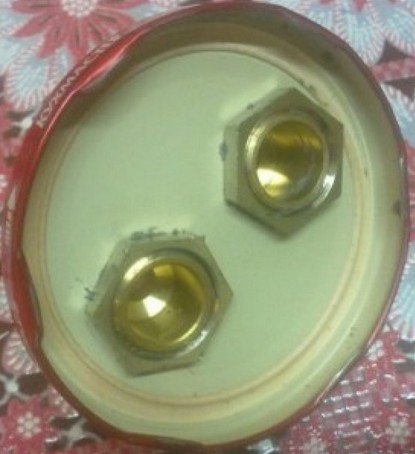
Connect two hoses to the fittings - one comes from the distillation cube, the other goes into the refrigerator.
It is best to make a steamer from stainless steel and provide for draining fusel oils. During distillation large quantity the mash begins to move, negatively affecting the taste of the final product.
Now the simplest moonshine still is ready!
For those who still have questions - video instructions from experienced moonshiners
In our country, moonshine stills are not new products; they are old, familiar units for preparing home-made drinks with a variety of additives. In Russia, they began making moonshine stills with their own hands during the period of strict Prohibition, when people were forced to look for other ways to obtain alcoholic beverages for the holidays.
The standard design of moonshine stills was known to both children and adults. Even those who did not have such devices at home understood the structure of these home helpers. Today the legislation is loyal to those who do alcoholic drinks for your own use. For selling, of course, there is a penalty. For many people, moonshine is now a hobby. He managed not only to preserve a unique tradition. Modern manufacturers of moonshine stills use advanced technologies, they choose materials high quality, constantly improve the design.
Stylish, laconic and multifunctional units are a source of pride. They are happily presented to friends and used to make a wide variety of drinks, which are practically not inferior to store-bought ones in quality and taste. Many beginners have a lot of questions when starting moonshine business. Encyclopedias, for example, Wikipedia, do not write about diagrams, drawings and photos of moonshine stills. And various forums and portals of folk craftsmen contain a lot of both useful and very dubious information. If you have firmly decided to create the structure yourself, then this guide and expert advice will come in handy.
Do-it-yourself moonshine still – it’s real!

Some people are intimidated by its complex system just by looking at the distiller. Despite the menacing appearance and many details, the circuit of the moonshine still, when analyzed in detail, is quite simple. The standard design consists of:
- Still. This is the main container into which the raw materials are placed. The tank is installed on a hob burner or on a stone stove, heats up, during which the mash boils, releasing vapors containing alcohol.
- Fridge. A cooling unit must be present in the circuit of any moonshine still. It is necessary to create condensation. When passing through the cooler, the vapor turns back into liquid and enters the collection container. It is very important to maintain an optimal temperature, just like in a distillation cube. In the simplest designs, cooling occurs due to the presence of this element in a container with water, which is replaced regularly when heated by the room temperature.
- Coil. An element of the refrigerator, which is represented by a curved tube, it is ideally made of a thin-walled stainless steel rod. The quality of the moonshine at the outlet directly depends on the length of the tube. It is recommended to use a workpiece of about 2 meters.
- Connecting tubes or hoses. They are an intermediate link between the distillation tank and the cooler. Water is supplied through silicone hoses and distillate flows out.
- Additional equipment. This includes all kinds of bimetallic thermometers, measuring containers, sealing gaskets, and heating elements.
Obviously, anyone can make a moonshine still at home if they have a great desire and the necessary parts at hand. You can use a regular pressure cooker as a distillation cube. It is initially equipped with a hermetically sealed lid, which simplifies the task. In the absence of such a pan in the house, you can use a metal flask, can or even a beer keg. It is important to observe the following condition: the container must have a tight-fitting lid.
You can also use aluminum flasks, stainless steel cans and other containers with a tight-fitting lid as a distillation cube. Below are the options that can be purchased from Alkopribor.
In the case of making a homemade cube or improving a flask, you should make sure that all seams are well sealed.
Stages of creating a moonshine still with your own hands
1. Alembic
We agreed to use a pressure cooker to serve as a distillation container. This good example for making moonshine at home, it is economical and easy to use. You can buy any pressure cooker or use an old one, upgrading will be easy in any case. The ideal still should be made of stainless steel, this is something to keep in mind. To strictly adhere to the technological process, it is necessary to install a thermometer, which must be laboratory, but not household. It’s easy to choose the model you need in the online store.
The thermometer is optional equipment. But thanks to its low cost, anyone can purchase a worthy copy. The benefits of constant temperature control are obvious. You can determine at any necessary time how to adjust the moonshine distillation process. This is very important during fractional distillation - timely separation of the “tails” and “heads” from the main part. For example, good moonshine collected at more high temperature, and when the “tails” begin to be rejected, it is better to reduce the temperature by strangling the gas. Experienced moonshiners are able to identify undesirable fractions by smell and by eye. It’s almost impossible for beginners to do this, so it’s definitely not worth saving on a thermometer.
If you decide to make a moonshine still with your own hands and do not want to take advantage of the achievements of progress, then you can study the fractions using alcohol meters and measuring cylinders, as our great-grandfathers did. It is known that the “heads” and “tails” account for approximately 10% of the total volume of the finished product. To use this formula, it is necessary to determine the yield of moonshine as accurately as possible. The thermometer allows you to analyze the strength of a liquid. When it falls, you can track the moment the “tails” appear.
When the strength of the alcohol-containing solution reaches 45% vol. a container is installed to collect the fraction. At the end of the distillation, the density of the liquid decreases and the temperature rises, so you need to immerse the alcohol meter deeper. Over time, you will learn to identify an obscene product by smell, but at the initial stage of moonshine brewing you need convenient devices.
2. Cooling system for home moonshine still
Many consider the coil to be the most complex element of the unit. But it’s quite simple to do if you follow a number of basic rules. It is important to choose the right material, because... Alcohol vapor will pass through the distiller coil. You can buy a cooler in the household goods department. A quartz glass cooler, if one can be found, will be good option. The inert material does not enter into chemical reactions with moonshine products, does not provide harmful effects for the finished drink.
b liquid strength. When it falls, you can track the moment the “tails” appear.

You can make a coil for a moonshine still with your own hands, with minimal time and effort. The classic refrigerator element consists of 5 turns. A stainless steel or copper tube is taken as a blank. The first option is more common, which is explained by the availability of the material, its high strength and durability. The copper coil conducts heat well, heating evenly over the entire surface. The metal itself is a catalyst that accelerates chemical processes well.
The distillate needs high-quality cooling throughout the entire time, and this can be several hours. Therefore, it is important to monitor the ambient temperature. The only negative is the high water consumption, so it is recommended to install a home moonshine still in close proximity to the main line.
Maximum cooling can be achieved in several ways:
1. The coil is placed in a container with water, which is regularly replaced with colder water.
2. Coil in the flow cooler. This option is the most convenient. To do this, the coil is welded into a pipe of larger diameter, in which nozzles and tubes are installed for supplying and discharging water. The hoses are connected to the tap.
3.The coil is cooled by 40 liters of water during the entire process. How is this possible? You can organize such an economical system using 2 buckets and a pump designed for an aquarium. It is important to maintain the optimal distance between containers of water: one bucket should stand at a height of 60 cm from the other. Water from the top container will flow into the cooler under the influence of gravity. A small pump will lift waste water upward, thus creating a cyclic process.
Try the moonshine while it’s still hot – this expression is familiar to many. But it should be understood not literally, but figuratively. If the output is a warm product, you need to think about the serviceability of the unit or cooling system. If you want good pure moonshine, the technology for preparing it must be recreated down to the smallest detail. The ideal distillate is always cold, and in some cases even icy.
3. Connecting elements
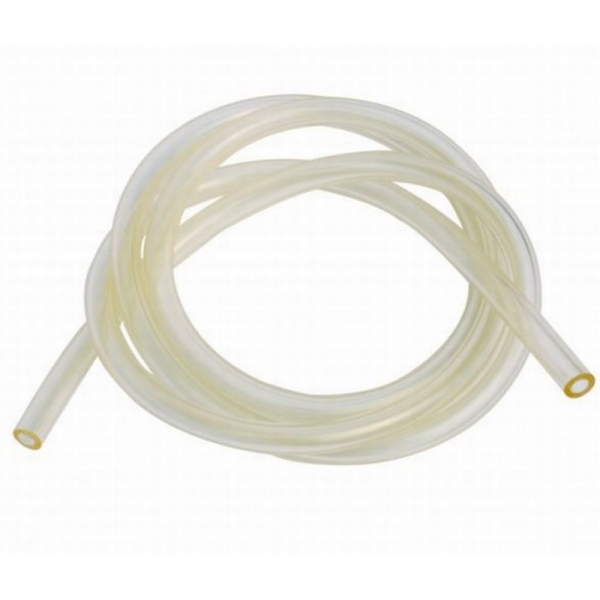
Hoses and tubes for connection must be selected no less carefully than the main equipment. They always come into contact with drinking liquids - water and ready-made moonshine. The most suitable in this case are silicone connecting hoses. They do not change the chemical composition of products, do not react with them, and do not emit an unpleasant odor.
To check the quality of the flexible tube, you can set fire to a section of it. Yes, rubber and plastic materials will always burn with the release of dark smoke and a pungent odor. At the same time, silicone ones smolder evenly, do not create soot, and leave behind white ash.
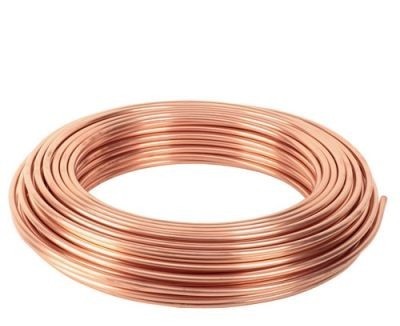
You can replace the silicone hose with a flexible copper tube. It can easily be found on the market if you decide to completely create a homemade moonshine still with your own hands and strength. An alternative can be corrugated connectors made of metal - high-alloy steel. You can even make a coil from such a liner 1.5-2 meters long.
The photographs below show a simple moonshine still, consisting of a copper coil and a pressure cooker. The cooler is connected to the distillation cube through a fitting. Instead of a refrigerator, a regular one is used plastic bottle volume 5 liters.

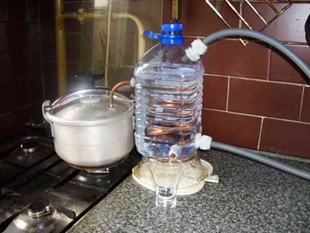
From above, water is supplied to the cooler through a hose, which in turn is connected to a cold water tap. Through the lower waste resource it is discharged into the sewer system. It is important to connect all connections well. To create a complete seal, you can use plumber's tape or silicone glue.
Through the lower hole of the coil, moonshine enters a measuring container, which can be of any size. This is an example of the simplest DIY moonshine still. More complex designs are equipped with steam traps, reflux traps and drawers. The final product depends on the design and quality of execution.
The Alkopribor company offers to familiarize yourself with the most popular types of moonshine stills that can be purchased in our store.
Now you can make a homemade moonshine still at home. If you decide that the search necessary materials, manufacturing individual units and parts of the distiller - all this is very difficult and time-consuming, you can contact our managers for help. They will select a professional moonshine still to suit your needs. It will have high strength characteristics, and in comparison with a homemade one it will look very chic and solid.
This is an example of the simplest DIY moonshine still. More complex designs are equipped with steam traps, reflux traps and drawers. The final product depends on the design and quality of execution.
You can make a moonshine still at home quickly and inexpensively. Its dimensions and other characteristics can be conveniently adjusted to personal requirements for the final product - moonshine. If you want to make a distillate based on berries or other fruits, it is better to choose a distillation cube and a copper coil. Stainless steel is excellent for making raw alcohol.
In Russia, the peak of popularity of moonshine occurred during the so-called “Prohibition Law.” Then almost the entire population was well versed in the structure and design of moonshine stills. Today, no one forbids making alcohol at home. Unless, of course, you are going to sell it - in which case the law is still harsh. But please your friends and loved ones with excellent drinks of your own production - why not? More and more people are choosing moonshine brewing as an unusual hobby, and the moonshine still, having come out of the underground, is becoming a source of pride, and sometimes even luxury. Moreover, many craftsmen (in in a good way words!) collect them with their own hands. If you have read a lot of advice on forums and special sites (Wikipedia is powerless here), looked at a lot of drawings and diagrams, photos and videos on this topic and decided to make a moonshine still with your own hands, then our practical guide will be useful to you.
No matter how impressive or even intimidating it may look, the mechanism of its operation is quite simple, and the basis of the design invariably consists of the following elements:
- Distillation cube. It contains raw materials that will be distilled when heated to the required temperature.
- Coil. This is a curved pipe placed in a cooling tank. Alcohol-containing vapors pass through it. It is believed that the longer the coil, the higher the quality of the final product.
- . Here, steam condenses into drops of alcohol, which flow from the coil through a special tube. As with the still, this container also needs to be maintained at a certain temperature. The easiest way to do this is by continuously supplying cold running water.
- Hoses (tubes). With their help, the distillation cube and the coil are connected, water is supplied and the distillate is drained.
- Additional accessories: thermometer, graduated cylinder, heating element, seals.
So, as you can see, to make a moonshine still at home, you don’t need any complex devices. To heat mash, wine and other alcohol-containing raw materials, you will need a pressure cooker. We chose this one because it provides complete tightness. Can also be used as a distillation cube
, or beer kegs and other containers with a tight-fitting lid. The main thing is to take care of sealing the seams. In addition, we need a coil, a refrigerator and connecting elements.First things first.
1. Distillation cube (container)
 A pressure cooker is an excellent option for making your own steam moonshine still. It has high tightness and is easy to purchase and upgrade. Give preference to stainless steel models with a lid that will fit tightly to the pan.
A pressure cooker is an excellent option for making your own steam moonshine still. It has high tightness and is easy to purchase and upgrade. Give preference to stainless steel models with a lid that will fit tightly to the pan.
It must be built into the distillation cube (pressure cooker).
In this case, you need to use not a household one, but a laboratory one, since the first one has too much error. Focusing on it, you can spoil the quality of the finished product. Installing a thermometer is not mandatory, but is highly recommended. This provides an additional opportunity to determine the right moment when separating harmful fractions (“head” and “tail”) from high-quality moonshine. So, at the end of distillation during selection, the temperature is reduced so that the output of the “tails” is slower and the selection is more thorough. When you master the “habits” of your distiller, you can do without a thermometer, relying on a “trained” eye. But it is better for novice moonshiners not to skimp on this device.Another way to exclude "head" factions is to use
Using simple mathematical calculations, you can determine how much of the total amount of liquid needs to be cut off (as a rule, this is 10% of the expected yield). The “head” fractions from 2 liters of moonshine will be approximately 200 ml. And to separate the “tails” use an alcohol meter. As soon as the strength of the output product reaches 45 degrees, stop the distillation process or collect the tailings in a separate container. Be careful when measuring strength. This is due to the fact that at the final stage the moonshine is hot, its density is reduced, therefore, the alcohol meter dives lower than necessary and gives inflated readings. Both the “tail” and “head” fractions have a stable bad smell, which is also an indicator.2. Types of cooling systems
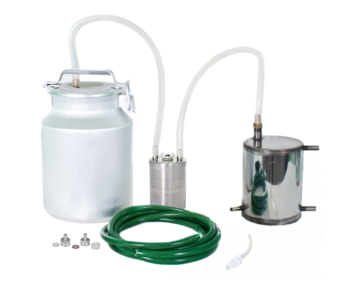 If there are usually no special difficulties with the distillation cube, then the coil will give you more trouble. It is also called a chiller. Vapors pass through it, and under the influence of low temperature they condense. If there is a chemical glassware store in your city, then it is best to buy a coil there. It can be called a quartz glass capacitor. Glass is chemically inert, it does not react with hot steam containing alcohol, and does not form harmful compounds or odors during distillation. You can look for chillers at flea markets and junkyards, or ask a friend who works in a chemical laboratory to get them.
If there are usually no special difficulties with the distillation cube, then the coil will give you more trouble. It is also called a chiller. Vapors pass through it, and under the influence of low temperature they condense. If there is a chemical glassware store in your city, then it is best to buy a coil there. It can be called a quartz glass capacitor. Glass is chemically inert, it does not react with hot steam containing alcohol, and does not form harmful compounds or odors during distillation. You can look for chillers at flea markets and junkyards, or ask a friend who works in a chemical laboratory to get them.
If none of the options suits you for one reason or another, try making a coil for a moonshine still with your own hands. A thin copper tube is best suited for the chiller. This material has excellent thermal conductivity, promoting uniform heating of the contents and its rapid cooling. Copper is a catalyst that speeds up chemical reactions. It precipitates harmful sulfur oxide, while maintaining the flavor and aromatic properties of the drink. You will need about a meter of tube. It is easy to buy in plumbing stores or construction markets. Take a round (cylindrical) object and wrap a tube around it. Immerse the resulting structure in a vessel filled with cold water.
Organizing coil cooling is a complex process. Distilling high-quality moonshine takes several hours. And all this time the chiller must be intensively cooled. It is worth remembering that the efficiency of the device depends on the temperature of the water around the coil. Unfortunately, water consumption during distillation can exceed several hundred liters.
The distillate must be cooled throughout the process. Do you have several possible options solutions to this problem.
First, you can place the coil in a large container of cold water (which needs to be replaced periodically). But this design takes up a lot of space.
Secondly, you can organize cooling of the coil with running water. To do this, you need access to a tap and a sewer drain in order to take cold water and send it to the sewer system, which has already spent its time, heated under the influence of the distillate.
 Thirdly, it is possible to organize a cooling system using an aquarium pump and two buckets. Buckets should be installed at a height difference of approximately 60 cm. Water from the upper bucket, under the influence of gravity, descends from the upper bucket through a cambric tube into a condenser connected to the lower hole. Water flows into the second bucket. It rises back due to the aquarium pump. Thanks to the low performance of the pump and the ability to easily adjust its speed, you will be able to achieve a balance of water flow and inflow. Thus, you will get a closed system. In this case, only 40 liters of water will be used to cool the coil.
Thirdly, it is possible to organize a cooling system using an aquarium pump and two buckets. Buckets should be installed at a height difference of approximately 60 cm. Water from the upper bucket, under the influence of gravity, descends from the upper bucket through a cambric tube into a condenser connected to the lower hole. Water flows into the second bucket. It rises back due to the aquarium pump. Thanks to the low performance of the pump and the ability to easily adjust its speed, you will be able to achieve a balance of water flow and inflow. Thus, you will get a closed system. In this case, only 40 liters of water will be used to cool the coil.
But maybe “fourthly” and “tenthly” - it’s up to you. The cooling system, as a rule, is assembled from improvised means at a person’s disposal.
There is an expression: “Taste the moonshine while it’s still hot.” But this is just a metaphor, a saying that means “in the heat of the moment.” Attention! If the moonshine at the outlet is really hot, then this indicates poor performance of your distiller or cooling system. High-quality moonshine, the preparation technology of which has been followed correctly, should come out cold, or even better, ice-cold.
3. Connecting elements

Another suitable option for making a homemade moonshine still is a copper tube. The properties of this alloy have already been listed above.
It is also possible to use a metal corrugated liner designed for gas or water. It can be made of non-ferrous metal or high-alloy stainless steel. Thanks to its length - up to 1.5 m, it can also be used to organize a coil,
avoiding unnecessary connections.
The fitting from the pressure cooker is connected to the chiller with a hose or metal tube.
The upper hose is connected to the kitchen faucet, the lower one is directed to the drain. The joints on the sides of the refrigerator are sealed (for these purposes, you can use silicone or rubber gaskets or FUM tape). This is done to prevent coolant leakage. The connecting tube is made of copper, and the drain pipe-tap is led out of the refrigerator. If everything is done correctly, the moonshine will flow into the measuring container in a thin stream.
We clearly showed you how to properly make a simple moonshine still with your own hands. More complex designs of distillers have various additional components, steam chambers, and drop eliminators (reflux condensers) to improve the quality of the finished product. All this can be made at home from improvised materials. It is best to assemble a moonshine still at home based on your own needs. To obtain raw alcohol, use large stainless steel containers. For fruit, berry and honey distillates, a copper cube and coil are suitable. Distillation of grain wort should only be done using a water bath to avoid burning it.
Now you know how to make a homemade moonshine still (mini version) at home. But is the game worth the candle? The search for improvised means, fixing the structure, checking hoses and tubes, creating a cooling system and, finally, the unaesthetic appearance of a homemade product are strong arguments in favor of purchasing a professional moonshine still. By choosing guaranteed quality equipment, you don’t have to worry about the safety of the finished product.



